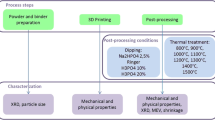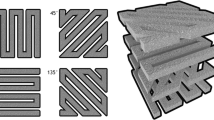Abstract
While various materials have been developed for bone substitute and bone tissue engineering applications over the last decades, processing techniques meeting the high demands of scaffold shaping are still under development. Individually adapted and mechanically optimised scaffolds can be derived from calcium phosphate (CaP-) ceramics via rapid prototyping (RP). In this study, porous ceramic scaffolds with a periodic pattern of interconnecting pores were prepared from hydroxyapatite, β-tricalcium phosphate and biphasic calcium phosphates using a negative-mould RP technique. Moulds predetermining various pore patterns (round and square cross section, perpendicular and 60° inclined orientation) were manufactured via a wax printer and subsequently impregnated with CaP-ceramic slurries. Different pore patterns resulted in macroporosity values ranging from about 26.0–71.9 vol% with pore diameters of approximately 340 μm. Compressive strength of the specimens (1.3–27.6 MPa) was found to be mainly influenced by the phase composition as well as the macroporosity, both exceeding the influence of the pore geometry. A maximum was found for scaffolds with 60 wt% hydroxyapatite and 26.0 vol% open porosity. It has been shown that wax ink-jet printing allows to process CaP-ceramic into scaffolds with highly defined geometry, exhibiting strength values that can be adjusted by phase composition and pore geometry. This strength level is within and above the range of human cancellous bone. Therefore, this technique is well suited to manufacture scaffolds for bone tissue engineering.










Similar content being viewed by others
References
Damien CJ, Parsons JR. Bone graft and bone graft substitutes: a review of current technology and applications. J Appl Biomater. 1991;2:187–208.
Habibovic P, de Groot K. Osteoinductive biomaterials—properties and relevance in bone repair. J Tissue Eng Regen Med. 2007;1:25–32.
Dorozhkin S, Epple M. Biological and medical significance of calcium phosphates. Angew Chem Int Ed Engl. 2002;41:3130–46.
Hing KH. Bone repair in the twenty-first century: biology, chemistry or engineering? Philos Transact A Math Phys Eng Sci. 2004;326:2821–50.
Rao WR, Boehm RF. A study of sintered apatites. J Dent Res. 1974;53:1351–4.
De With G, Van Dijk HJA, Hattu N, Prijs K. Preparation, microstructure and mechanical properties of dense polycrystalline hydroxy apatite. J Mater Sci. 1981;16:1592–8.
Dorozhkin SV. Bioceramics of calcium orthophosphates. Biomaterials. 2009;31(7):1465–85.
Akao M, Aoki H, Kato K. Mechanical properties of sintered hydroxyapatite for prosthetic applications. J Mater Sci. 1981;16:809–12.
Metsger DS, Rieger MR, Foreman DW. Mechanical properties of sintered hydroxyapatite and tricalcium phosphate ceramic. J Mater Sci Mater Med. 1999;10:9–17.
Driessen AA, Klein CP, de Groot K. Preparation and some properties of sintered beta-whitlockite. Biomaterials. 1982;3:113–6.
Jarcho M, Bolen CH, Thomas MB, Bobick J, Kay JF, Doremus RH. Hydroxylapatite synthesis and characterization in dense polycrystalline form. Synthesis and fabrication of β-tricalcium phosphate (whitlockite) ceramics for potential prosthetic applications. J Mater Sci. 1979;14:142–50.
Daculsi G. Biphasic calcium phosphate concept applied to artificial bone, implant coating and injectable bone substitute. Biomaterials. 1998;19:1473–8.
Alam MI, Asahina I, Ohmamiuda K, Takahashi K, Yokota S, Enomoto S. Evaluation of ceramics composed of different hydroxyapatite to tricalcium phosphate ratios as carriers for rhBMP-2. Biomaterials. 2001;22:1643–51.
Rice JM, Hunt JA, Gallagher JA. Quantitative evaluation of the biocompatible and osteogenic properties of a range of biphasic calcium phosphate (BCP) granules using primary cultures of human osteoblasts and monocytes. Calcif Tissue Int. 2003;72:726–36.
Mayr H, Schlüfter S, Detsch R, Ziegler G. Influence of phase composition on degradation and resorption of biphasic calcium phosphate ceramics. Key Eng Mat. 2008;361–363:1043–6.
Daculsi G, Laboux O, Malard O, Weiss P. Current state of the art of biphasic calcium phosphate bioceramics. J Mater Sci Mater Med. 2003;14:195–200.
Hing KA. Bioceramic bone graft substitutes: influence of porosity and chemistry. Int J Appl Ceram Technol. 2005;2:184–9.
Karageorgiou V, Kaplan D. Porosity of 3D biomaterial scaffolds and osteogenesis. Biomaterials. 2005;26:5474–91.
Frosch K, Barvencik F, Viereck V, Lohmann CH, Dresing K, Breme J, Brunner E, Sturmer KM. Growth behavior, matrix production, and gene expression of human osteoblasts in defined cylindrical titanium channels. J Biomed Mater Res A. 2004;68:325–34.
Liu D. Influence of porosity and pore size on the compressive strength of porous hydroxyapatite ceramic. Ceram Int. 1997;23:135–9.
Rice RW. Comparison of stress concentration versus minimum solid area based mechanical property-porosity relations. J Mater Sci. 1993;28:2187–90.
Gibson LJ, Ashby MF. Cellular solids—structure and properties. 2nd ed. ed. Cambridge, UK: Cambridge University; 1997.
Zyman ZZ, Tkachenko MV, Polevodin DV. Preparation and characterization of biphasic calcium phosphate ceramics of desired composition. J Mater Sci Mater Med. 2008;19:2819–25.
Kwon S, Jun Y, Hong S, Lee I, Kim H, Won YY. Calcium phosphate bioceramics with various porosities and dissolution rates. J Am Ceram Soc. 2002;85:3129–31.
Guo G, Xu K, Han Y. The in situ synthesis of biphasic calcium phosphate scaffolds with controllable compositions, structures, and adjustable properties. J Biomed Mater Res B Appl Biomater. 2007;88A:43–52.
Raynaud S, Champion E, Lafon JP, Bernache-Assolant D. Calcium phosphate apatites with variable Ca/P atomic ratio III. Mechanical properties and degradation in solution of hot pressed ceramics. Biomaterials. 2002;23:1081–9.
Royer A, Viguie JC, Heughebaert M, Heughebaert JC. Stoichiometry of hydroxyapatite: influence on the flexural strength. J Mater Sci Mater Med. 1993;4:76–82.
Gauthier O, Bouler JM, Aguado E, Legeros RZ, Pilet P, Daculsi G. Elaboration conditions influence physicochemical properties and in vivo bioactivity of macroporous biphasic calcium phosphate ceramics. J Mater Sci Mater Med. 1999;10:199–204.
Wang X, Fan H, Xiao Y, Zhang X. Fabrication and characterisation of porous hydroxyapatite/β-tricalcium phosphate ceramics by microwave sintering. Mater Lett. 2006;60:455–8.
Puértolas JA, Vadilloa JL, Sánchez-Salcedoc S, Nietoc A, Gómez-Barrenae E, Vallet-Regí M. Compression behaviour of biphasic calcium phosphate and biphasic calcium phosphate–agarose scaffolds for bone regeneration. Acta Biomater. 2010. doi:10.1016/j.actbio.2010.07.032.
Deschamps AA, Claase MB, Sleijster WJ, de Bruijn JD. Design of segmented poly(ether ester) materials and structures for the tissue engineering of bone. J Control Release. 2002;78:175–86.
Deisinger U, Stenzel F, Ziegler G. Development of hydroxyapatite ceramics with tailored pore structure. Key Eng Mater. 2004;254–256:977–80.
Michna S, Wu W, Lewis J. Concentrated hydroxyapatite inks for direct-write assembly of 3-D periodic scaffolds. Biomaterials. 2005;26:5632–9.
Deisinger U, Irlinger F, Pelzer R, Ziegler G. 3D-Printing of HA-scaffolds for the application as bone substitute material. cfi-Ceram Forum Int. 2006;83:75–8.
Vorndran E, Klamer M, Klammert U, Grover LM, Patel S, Barralet JE, Gbureck U. 3D powder printing of b-tricalcium phosphate ceramics using different strategies. Adv Eng Mat. 2009;10:B67–71.
Deisinger U, Leiderer M, Detsch R, Hamisch S, Ziegler G. Extrusion freeform fabrication technique for tailoring hydroxyapatite scaffolds for bone tissue engineering applications. Cytotherapy. 2006;S2:15.
Simon JL, Michna S, Lewis JA, Rekow ED, Thompson VP, Smay JE, Yampolsky A, Parsons JR, Ricci JL. In vivo bone response to 3D periodic hydroxyapatite scaffolds assembled by direct ink writing. J Biomed Mater Res A. 2007;83:747–58.
Rumpler M, Woesz A, Varga F, Manjubala I, Klaushofer K, Fratzl P. Three-dimensional growth behavior of osteoblasts on biomimetic hydroxylapatite scaffolds. J Biomed Mater Res A. 2007;81:40–50.
Chu TM, Halloran JW, Hollister SJ. Hydroxyapatite implants with designed internal architecture. J Mater Sci Mater Med. 2001;12:471–8.
Deisinger U, Hamisch S, Schumacher M, Uhl F, Detsch R, Ziegler G. Fabrication of tailored hydroxyapatite scaffolds: comparison of a direct and an indirect rapid prototyping technique. Key Eng Mat. 2008;361–363:915–8.
Limpanuphap S, Derby B. Manufacture of biomaterials by a novel printing process. J Mater Sci Mater Med. 2002;13:1163–6.
Taboas JM, Maddox RD, Krebsbach PH, Hollister SJ. Indirect solid free form fabrication of local and global porous, biomimetic and composite 3D polymer-ceramic scaffolds. Biomaterials. 2003;24:181–94.
Chu TG, Warden SJ, Turner C. Segmental bone regeneration using a load-bearing biodegradable carrier of bone morphogenetic protein-2. Biomaterials. 2007;28:459–67.
Rumpler M, Woesz A, Dunlop JW, van Dongen JT, Fratzl P. The effect of geometry on three-dimensional tissue growth. J R Soc Interface. 2008;5:1173–80.
Deisinger U. Synthetisches Knochenersatzmaterial mit spongiosa-ähnlicher Struktur: Herstellung, materialwissenschaftliche Charakterisierung und biologisches Verhalten von Calciumphosphat-basierten Keramiken. Berlin: Mensch-und-Buch-Verlag; 2009.
Hattiangadi A, Bandyopadhyay A. Modeling of multiple pore ceramic materials fabricated via fused deposition process. Scripta Mater. 2000;42:581–8.
Tsukrov I, Kachanov M. Stress concentrations and microfracturing patterns in a brittle-elastic solid with interacting pores of diverse shapes. Int J Solids Struct. 1997;34:2887–904.
Carter DR, Haynes WC. The compressive behaviour of bone as a two-phase porous structure. J Bone Joint Surg Am. 1977;59:954–62.
Detsch R, Uhl F, Deisinger U, Ziegler G. 3D-Cultivation of bone marrow stromal cells on hydroxyapatite scaffolds fabricated by dispense-plotting and negative mould technique. J Mater Sci Mater Med. 2008;19:1491–6.
Rumpler M, Woesz A, Dunlop JW, van Dongen JT, Fratzl P. The effect of geometry on three-dimensional tissue growth. J R Soc Interface. 2008;5:1173–80.
Author information
Authors and Affiliations
Corresponding author
Rights and permissions
About this article
Cite this article
Schumacher, M., Deisinger, U., Detsch, R. et al. Indirect rapid prototyping of biphasic calcium phosphate scaffolds as bone substitutes: influence of phase composition, macroporosity and pore geometry on mechanical properties. J Mater Sci: Mater Med 21, 3119–3127 (2010). https://doi.org/10.1007/s10856-010-4166-6
Received:
Accepted:
Published:
Issue Date:
DOI: https://doi.org/10.1007/s10856-010-4166-6




